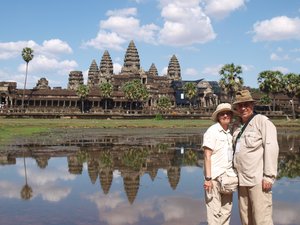Advertisement

 Angkor Wat
Angkor Wat
The classic poseIt felt good to be somewhere a bit quieter for our last stop on our tour and I was happy to find both peanut butter and passion fruits (to go on my morning yoghurt) on the breakfast buffet.
Our guide told us that Cambodia has one thousand temples. The last one to be built was the Bayon temple, because up until then (1190), Cambodia grew great quantities of rice and was wealthy. Then drought hit (global climate change!). Some of the temples were built as Buddhist temples, some Hindu. Many changed from one to the other. It depended on the current king. The four faces, carved repeatedly on the Bayon temple walls, represent charity, equanamity, compassion, and sympathy, the four divine states of mind of the king. The temple had two libraries but what with termites and the humidity, the papyrus books didn't fare well. When the Cham people arrived, they converted Bayon to a Hindu temple and chiseled out all of the Buddhas, or changed them into lingas.
The most famous temple of course is Angkor Wat, the largest religious building in the world and, even now, it is magnificent and unique in the fact that it faces

 Angkor Thom
Angkor Thom
One of the many faces at Angkor Thomwest. Experts think this is likely because it was a mausoleum so faces the setting sun.
The best carvings we saw were at Banteay Srei temple because it was built from a different sandstone than all the others, pinkish-yellow in colour, that is harder and has weathered better.
Unlike the Vietnamese who believe in burial, Cambodians believe in cremation. Prerupi Temple was used as a crematorium and has two rectangular rooms with high chimneys. The remains came out black, which was not a holy colour, so they were washed in coconut milk to lighten them. Sometimes the remains after cremation were left out for the animals to eat. If they were all gone after two weeks then the deceased had been a good person. If some of the remains were still there, the person was considered to be unwholesome.
We also had a look round Ta Prohm Temple, which is partly overgrown by trees and featured in Angelina Jolie's movie Tomb Raider. Sadly many pieces from the temples have been stolen over the centuries. Even parts of statue replica's have more recently been stolen.
According to our guide, Cambodia still has 5-6 million mines left over

 Angkor Thom
Angkor Thom
Entrance gatefrom the war and they are plastic so they have to use sniffer dogs to find them, rather than metal detectors, a slow process. He guessed it would take 100 years to remove them all.
Like other poor countries, school is free but students must buy books, uniforms, etc., to attend and if they want to attend for more than half a day they have to pay for the extra half day. We passed a cluster of people outside a free children's hospital around noon and were told the parents of the patients were taking them lunch. Last year during the rainy season, a huge number of children were hospitalized with Denge fever so health officials are trying to prepare, and stockpile blood donations, for this rainy season. There's nothing like travel to make us appreciate what we have at home.
Advertisement
Tot: 0.091s; Tpl: 0.01s; cc: 11; qc: 25; dbt: 0.0577s; 1; m:domysql w:travelblog (10.17.0.13); sld: 1;
; mem: 1mb

 Angkor Wat
Angkor Wat
 Angkor Thom
Angkor Thom
 Angkor Thom
Angkor Thom










